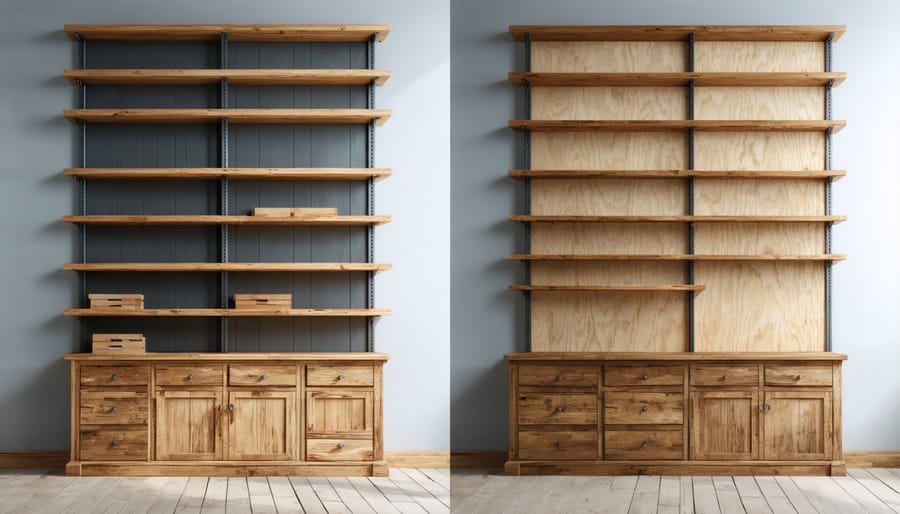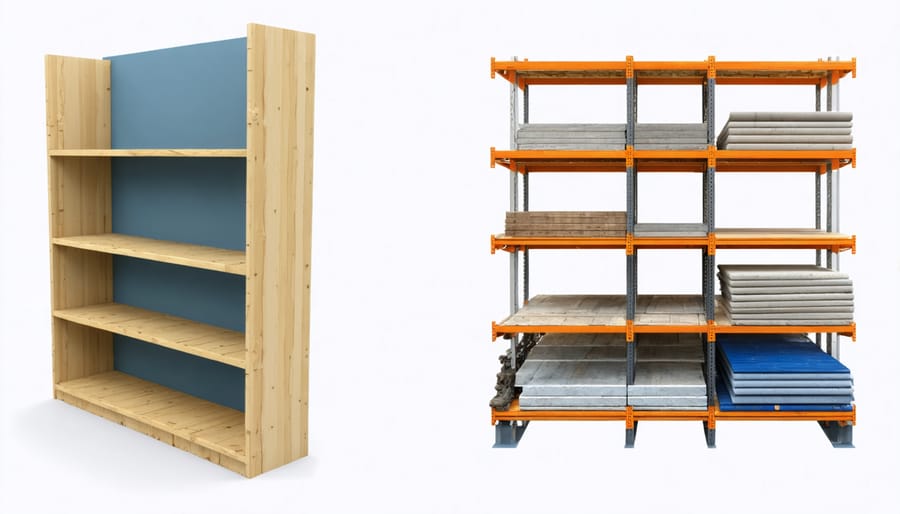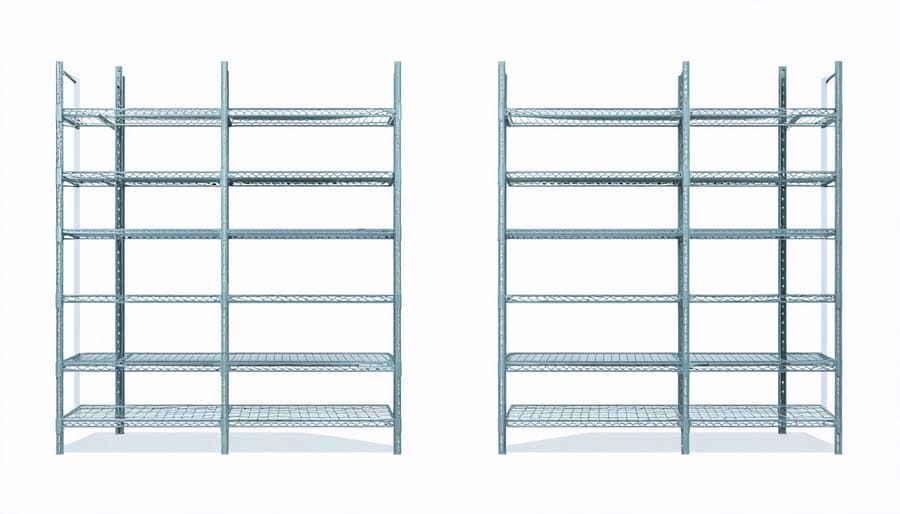Choosing the right material for your closet shelves can transform your storage space from chaotic to organized. Whether you’re installing custom closet organization systems or building standalone shelves, your material choice impacts durability, cost, and aesthetic appeal. Solid wood offers timeless beauty and exceptional strength but requires regular maintenance and comes at a premium price. Melamine-coated particleboard provides an affordable, moisture-resistant alternative that’s perfect for most closets, while wire shelving delivers excellent ventilation and easy installation for budget-conscious homeowners. Consider your specific storage needs, weight requirements, and local climate conditions when selecting materials – heavy winter coats demand sturdier solutions than lightweight summer wear, while humid environments require moisture-resistant options to prevent warping and mold growth.
Popular Closet Shelf Materials Compared
Solid Wood vs. Engineered Wood
When it comes to closet shelving, the choice between solid wood and engineered wood often boils down to your specific needs and budget. Solid wood, such as pine, oak, or maple, offers natural beauty and exceptional durability. It can withstand heavy loads without sagging and, with proper care, can last for decades. You can sand and refinish solid wood multiple times, making it perfect for those who want long-term versatility.
Engineered wood products, including MDF (Medium-Density Fiberboard) and particle board, offer their own advantages. These materials are more affordable and come in consistent sizes and textures. MDF, in particular, has a smooth surface that takes paint well and resists warping better than solid wood. Particle board, while the most budget-friendly option, works best for lighter loads and in climate-controlled spaces.
Consider these quick comparisons:
– Solid Wood: More expensive, naturally beautiful, extremely durable, can be refinished
– MDF: Mid-range price, uniform texture, good paint surface, moderate durability
– Particle Board: Most affordable, decent for light use, requires careful moisture control
For most closets, a hybrid approach often works best. Consider using solid wood for heavily loaded shelves and engineered wood for lighter-duty areas. This strategy helps balance cost with performance while ensuring your closet storage remains sturdy and functional for years to come.

Wire Shelving Systems
Wire shelving systems have become increasingly popular for closet organization, and it’s easy to see why. These ventilated shelves, typically made from vinyl-coated steel wire, offer a perfect blend of durability and functionality. The open design allows for excellent air circulation, which helps prevent musty odors and keeps your clothes fresher for longer.
One of the biggest advantages of wire shelving is its versatility. You can easily adjust shelf heights to accommodate different items, and the continuous airflow helps prevent dust accumulation. The vinyl coating not only protects against rust but also provides a smooth surface that won’t snag delicate fabrics.
Installation is generally straightforward, with many systems featuring snap-together components that don’t require special tools. While wire shelving might not have the same luxurious look as solid wood, it’s incredibly practical and cost-effective. Most systems can hold significant weight – typically 30-50 pounds per linear foot when properly installed.
Keep in mind that smaller items might need containers or bins, as they can slip through the wire gaps. However, this same feature makes wire shelving perfect for closets in humid areas, where solid shelving might trap moisture.
Melamine and Laminate Options
Melamine and laminate shelving options offer an excellent middle ground between affordability and durability. These materials consist of particleboard or MDF cores with a protective coating that resists scratches, moisture, and everyday wear. Melamine features a thin, plastic-like finish that’s bonded directly to the board, making it an economical choice for basic closet systems. It comes in various colors and wood-grain patterns, allowing you to match your existing décor.
Laminate, while similar, typically offers a thicker, more durable surface layer than melamine. It’s more resistant to chipping and can better withstand heavy use, making it ideal for frequently accessed closets. Both materials are easy to clean with just a damp cloth and mild soap, requiring minimal maintenance over their lifetime.
When shopping for these materials, look for boards with sealed edges to prevent moisture absorption and extend shelf life. While not as prestigious as solid wood, these options provide reliable performance at a fraction of the cost, making them popular choices for modern closet systems.
Weight Capacity and Span Considerations
Maximum Load Ratings
Understanding weight limits is crucial for safe and functional closet shelving. For solid wood shelves spanning 36 inches, expect to safely hold 30-40 pounds per linear foot when properly supported. Pine can handle around 30 pounds per foot, while hardwoods like oak can support up to 40 pounds per foot.
Particleboard and MDF shelves should carry less weight, typically 15-25 pounds per linear foot. These materials are more prone to sagging over time, especially in humid environments. Wire shelving systems, when properly installed, can typically support 30-50 pounds per linear foot, making them surprisingly sturdy for their appearance.
To maximize load capacity, consider these key factors:
– Reduce span length between supports (24-inch spacing is ideal)
– Use thicker material (¾-inch minimum for wood, 1-inch preferred for heavy loads)
– Install additional support brackets
– Choose appropriate mounting hardware rated for your intended load
For walk-in closets with hanging clothes, plan for about 10-15 pounds per linear foot for typical clothing items. Double that capacity if you’re storing heavy winter coats or formal wear. Built-in drawer units should be designed to handle 30-40 pounds per drawer, depending on size and construction method.
Remember that these ratings assume proper installation with appropriate wall anchors and supports. When in doubt, it’s always better to over-engineer your shelving system than risk a collapse.
Preventing Shelf Sag
Preventing shelf sag is crucial when designing your closet storage system to effectively maximize storage space without compromising stability. As a general rule, shelves longer than 32 inches need additional support to prevent bending under weight over time.
For shelves up to 36 inches, solid wood or 3/4-inch plywood can typically handle most loads without sagging. However, when extending beyond this length, you’ll want to incorporate support brackets every 24-32 inches. Metal support brackets, while visible, provide excellent stability and can handle heavy loads.
A clever alternative is installing a wooden cleat along the back wall, which offers hidden support while maintaining a clean look. For maximum stability, consider these span-to-thickness ratios:
– 3/4-inch material: Maximum 36-inch span
– 1-inch material: Maximum 42-inch span
– 1.5-inch material: Maximum 48-inch span
When using particleboard or MDF, reduce these spans by about 25% to account for their lower structural strength. For adjustable shelving systems, using metal standards and brackets provides flexibility while ensuring proper support at regular intervals.
Remember that proper support isn’t just about preventing immediate sagging – it’s about maintaining the shelf’s integrity over years of use. Even slight bowing can eventually lead to permanent deformation, so it’s better to err on the side of extra support.

Cost vs. Durability Analysis
Budget-Friendly Options
When budget is a primary concern, several affordable materials can still deliver excellent results for your closet shelves. Melamine-coated particleboard stands out as a popular choice, offering a clean, white finish and decent durability at a fraction of the cost of solid wood. This material works well with most home organization solutions and is readily available at most home improvement stores.
MDF (Medium-Density Fiberboard) represents another cost-effective option, especially when painted or laminated. While not as moisture-resistant as some pricier alternatives, proper sealing and careful use make it a reliable choice for dry closet environments.
Wire shelving systems deserve consideration for their affordability and versatility. These pre-fabricated units typically cost less than solid shelving materials and offer excellent ventilation for clothing storage. Plus, they’re incredibly easy to install and maintain.
For those willing to put in some extra effort, repurposed materials can be an incredibly budget-friendly approach. Old bookcases, salvaged wooden planks, or even sturdy plywood can be transformed into functional closet shelves with proper preparation and finishing. Just ensure any recycled materials are thoroughly cleaned, sanded, and sealed before use.
Premium Materials Worth the Investment
While budget-friendly options can get the job done, investing in premium materials can significantly enhance your closet’s functionality and aesthetics. Solid hardwoods like maple, cherry, and walnut offer unmatched durability and a luxurious appearance that can last generations. These woods develop a beautiful patina over time and can be refinished multiple times, making them truly lifetime investments.
High-grade plywood, particularly Baltic birch or marine-grade options, represents another premium choice. These materials feature more layers and fewer voids than standard plywood, resulting in exceptional stability and strength. They’re less likely to warp or sag, even under heavy loads.
For a modern look, consider architectural-grade melamine or high-pressure laminate (HPL). These materials offer superior scratch and moisture resistance compared to their basic counterparts, with more sophisticated finishes that convincingly mimic natural materials. Some premium versions even include antimicrobial properties and UV protection.
Custom-cut glass shelving, while expensive, creates an elegant, floating appearance that’s perfect for displaying accessories or designer items. Tempered glass options provide excellent durability and safety, while textured or frosted varieties add visual interest.
Remember that premium materials often come with extended warranties and better customer support, adding value beyond their physical properties.
Installation and Maintenance Requirements
DIY-Friendly Materials
For DIY enthusiasts excited about building your dream closet, several materials are particularly well-suited for self-installation. Melamine-coated particleboard tops the list as it comes pre-finished, requires minimal tools, and is readily available at home improvement stores. It’s lightweight, easy to cut with basic power tools, and features a smooth surface that’s perfect for closet use.
Another DIY-friendly option is MDF (Medium-Density Fiberboard), which offers excellent stability and a smooth surface for painting. It’s heavier than particleboard but still manageable for solo installation. Pre-finished wire shelving systems are perhaps the most DIY-friendly, requiring minimal tools and typically including all necessary mounting hardware.
Pine boards are also popular among DIY-ers, as they’re lightweight, easy to cut, and can be customized with stains or paint. While they may require more finishing work, they’re forgiving for beginners and can be easily modified if you make mistakes during installation. Just remember to seal pine properly to prevent warping from moisture.

Professional Installation Recommendations
While many closet shelf installations can be DIY projects, certain materials and situations warrant professional installation. Custom-cut solid wood shelving typically requires experienced hands, especially when dealing with complex measurements or built-in designs. If you’re opting for wire shelving systems that span entire walls or installing heavy-duty melamine units, a professional installer can ensure proper weight distribution and secure anchoring to wall studs.
Consider professional help when working with materials that need precise cutting, such as glass or high-end hardwoods, as these require specialized tools and expertise. Additionally, if your closet design includes integrated lighting, electrical work should always be handled by licensed professionals.
Professional installation is particularly valuable for walk-in closets or when installing floor-to-ceiling systems. These projects often involve multiple components and require careful planning to maximize space efficiency. While it may add to your initial costs, professional installation can prevent costly mistakes and ensure your shelving system lasts longer with proper support and installation techniques.
Remember, many material suppliers offer installation services, which can be convenient as they’re already familiar with their products’ specific requirements and warranty terms.
Care and Cleaning Tips
Keeping your closet shelves in top condition doesn’t have to be complicated. For wood shelves, dust regularly with a soft cloth and treat with furniture polish every few months to maintain their appearance. If you spot any stains, clean them promptly with a damp cloth and mild soap, making sure to dry the surface thoroughly to prevent warping.
Wire shelving is particularly easy to maintain – simply wipe down with a damp cloth and all-purpose cleaner. For stubborn dirt, remove the shelves and wash them in your bathtub with warm, soapy water. Melamine and laminate shelves can be cleaned with a gentle all-purpose cleaner, but avoid harsh abrasives that might scratch the surface.
Metal shelving requires occasional dusting and can be wiped clean with a slightly damp cloth. In humid areas, check periodically for signs of rust and address any spots immediately with appropriate rust treatment. For glass shelves, use a standard glass cleaner and lint-free cloth to maintain their sparkle while avoiding streaks.
Remember to check all mounting hardware every six months and tighten any loose screws or brackets to ensure your shelves remain secure and safe.
Choosing the right material for your closet shelves ultimately depends on your specific needs, budget, and lifestyle. For those seeking durability and a classic look, solid wood remains an excellent all-around choice, though it comes with a higher price tag. Melamine and laminated particle board offer practical, budget-friendly solutions that work well in most closets, especially if you’re renting or working with a tight budget.
For those prioritizing strength and longevity, wire shelving systems provide outstanding durability and ventilation, making them perfect for heavy-duty storage needs. MDF presents a happy medium, offering good durability and a smooth finish at a reasonable price point, though it requires proper sealing in humid environments.
Consider your storage needs, local climate, and installation capabilities when making your final decision. If you’re storing heavy items, opt for solid wood or wire shelving. For lighter items and a clean appearance, melamine or MDF will serve you well. Remember that proper installation is just as important as material selection – even the strongest materials won’t perform well if not installed correctly.
Whatever material you choose, ensure it’s properly sealed and supported to maximize its lifespan and functionality in your closet space.
